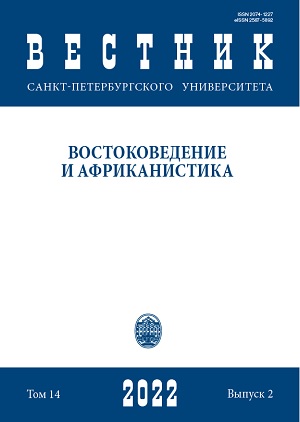On Special Verbs of Motion in Turkmen and Their Possible Etymological Connection with the Marker tas in Turkmen
DOI:
https://doi.org/10.21638/spbu13.2022.208Abstract
Turkmen, when expressing the avertive meaning “an event almost realized”, applies an obligatory marker tas. Turkmen grammars traditionally describe it as a word that gives a negative connotation to the meaning <an action was possible but did not happen>. However, in Turkic linguistics and in Turkmen in particular, the status of tas as a modal word or a grammatical particle has not yet been studied. Moreover, there are no studies in Turcological linguistics, offering classifications of modal words and particles which are shaped on the basis of their meanings as well as grammatical and pragmatic functions. Nevertheless, the marker tas is of interest for the following two reasons. First, the narrow scope of use in Turkmen, i.e. only to express the avertive meaning. Second, the issue of the etymology of the roots tas-/daz-/tis- in Turkic languages is still one of the discussed matters. Moreover, there are various suggestions about their etymology, including the hypothesis of their Mongolian origin. In this context, the following paper aims to discuss a possible lexical origin of the marker tas in Turkmen, focusing on a special group of verbs of motion with the roots tas-/daz-/tis-. These verbs are of interest since they contain information not only about direction of motion but also: a) information about a manner of movement, b) judgment of the manner of movement, and c) information about emotional state, such as fear.
Keywords:
Turkmen, avertive in Turkmen, modality, verbs of motion in Turkic, verbs of motion in Turkmen, Chuvash, Yakut, Khakas, grammaticalization in Turkic
Downloads
References
Downloads
Published
How to Cite
Issue
Section
License
Articles of "Vestnik of Saint Petersburg University. Asian and African Studies" are open access distributed under the terms of the License Agreement with Saint Petersburg State University, which permits to the authors unrestricted distribution and self-archiving free of charge.





